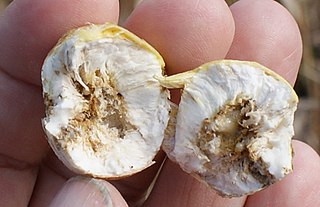
A spruce is a tree of the genus Picea, a genus of about 35 species of coniferous evergreen trees in the family Pinaceae, found in the northern temperate and boreal (taiga) regions of the Earth. Spruces are large trees, from about 20–60 m tall when mature, and have whorled branches and conical form. They can be distinguished from other members of the pine family by their needles (leaves), which are four-sided and attached singly to small persistent peg-like structures (pulvini) on the branches, and by their cones, which hang downwards after they are pollinated. The needles are shed when 4–10 years old, leaving the branches rough with the retained pegs. In other similar genera, the branches are fairly smooth.
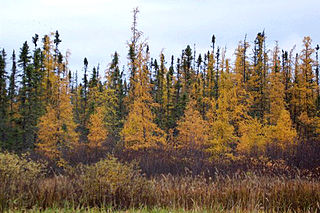
Larix laricina, commonly known as the tamarack, hackmatack, eastern larch, black larch, red larch, or American larch, is a species of larch native to Canada, from eastern Yukon and Inuvik, Northwest Territories east to Newfoundland, and also south into the upper northeastern United States from Minnesota to Cranesville Swamp, West Virginia; there is also an isolated population in central Alaska. The word tamarack is an Algonquian name for the species and means "wood used for snowshoes".

Picea glauca, the white spruce, is a species of spruce native to the northern temperate and boreal forests in North America. Picea glauca was originally native from central Alaska all through the east, across southern/central Canada to the Avalon Peninsula in Newfoundland. It now has become naturalized southward into the far northern United States border states like Montana, Minnesota, Wisconsin, Michigan, Vermont, New Hampshire and Maine; there is also an isolated population in the Black Hills of South Dakota and Wyoming. It is also known as Canadian spruce, skunk spruce, cat spruce, Black Hills spruce, western white spruce, Alberta white spruce, and Porsild spruce.
Hylobius warreni, Warren's rootcollar weevil, is a common pest of spruce and pine throughout Canada. It causes considerable damage to native species of spruce both in natural stands and in plantations.
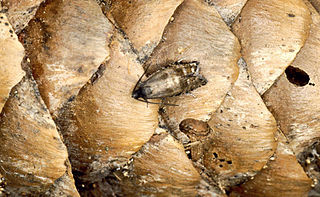
Cydia strobilella, the spruce seed moth, is a moth of the Tortricidae family. It is found in Europe.

Zeiraphera canadensis, the spruce bud moth, is a moth of the family Tortricidae. It is a small brown moth mainly found in North America, specifically New Brunswick, Quebec, and the Northeast region of the United States. The adult moth flutters quickly, and stays low among trees during the day and higher above tree cover after sunset. The spruce bud moth relies primarily on the white spruce tree as a host plant. Both male and female spruce bud moths mate multiply, however males have the ability to secrete accessory gland proteins that prevent female re-mating. The moth is univoltine, meaning only one generation hatches per year, and its eggs overwinter from July to May. The species Z. ratzeburgiana is very similar to Z. canadensis and can only be distinguished by the presence of an anal comb in Z. canadensis.
Epinotia nanana, the European spruce needleminer, is a moth of the Tortricidae family. It is found from northern and central Europe to Russia and Mongolia.

Dendroctonus rufipennis, the spruce beetle, is a species of bark beetle native to British Columbia, Newfoundland and Labrador, Nova Scotia, Ontario, Quebec, the Yukon, Colorado, Wyoming, Montana, and Maine. They are known to destroy forests of spruce trees including Englemann, White, Sitka, and Colorado blue spruce. Adults average 4 to 7 mm in length.
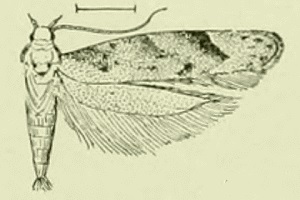
Coleotechnites piceaella is a moth of the family Gelechiidae. It is found in north-eastern United States and Canada. It is an introduced species in Europe and was first recorded from Great Britain in 1952, then Germany in 1963 and has expanded from there over all of central Europe, towards France, Italy and Hungary.
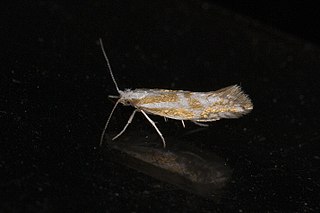
Argyresthia abdominalis is a moth of the family Yponomeutidae. It is found in most of Europe, except Ireland, the Iberian Peninsula, Slovenia, Greece, Ukraine and Lithuania.

Argyresthia glabratella, the spruce argent, is a moth of the family Yponomeutidae. It is found in most Europe, except Ireland, the Iberian Peninsula, Hungary, Slovenia, Croatia and Greece.
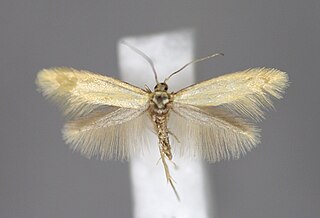
Argyresthia illuminatella is a moth of the family Yponomeutidae. It is found in most Europe, except Ireland, Great Britain, Portugal, Fennoscandia, Hungary, Slovenia and Greece.
Argyresthia laricella, the larch shoot moth, is a moth of the family Yponomeutidae. It is found in Canada, including north-western Ontario, Nova Scotia, south-eastern Manitoba, Saskatchewan, western Alberta and southern British Columbia.
Argyresthia mariana, the graybanded leafroller, is a moth of the family Yponomeutidae. It is found in Canada in northern Ontario and possibly Alberta.
Archips packardianus, the spring spruce needle moth or spruce needleworm, is a species of moth of the family Tortricidae. Spruce needle worms are commonly found in small numbers on spruce and trees of other coniferous genera throughout most of Canada and the northeastern US. Archips packardiana overwinters as a tiny larva in a mined needle. Needle mining is resumed in the spring, the larvae later moving to feed on new foliage, where they spin considerable webbing. Full-grown larvae have a pale green head, sometimes patterned with brown, and a pale body and pale thoracic legs, and are about 20 mm long. The larva pupates, usually in the webbed needles, and the adult emerges in summer to early fall. The closely related Archips strianus is much less common, but probably has a habitat similar to that of A. packardiana. The larvae have dark thoracic legs and small dark areas around the base of the thoracic hairs. The habitat consists of coniferous and mixed woods.
Clepsis persicana, the white triangle tortrix or the green needleworm, is a species of moth of the family Tortricidae. It is found in North America, where it has been recorded from Alaska and British Columbia to Newfoundland and south to Virginia and west to California. The habitat consists of coniferous and mixed coniferous forests.

Megastigmus atedius is a species of minute wasp that feeds on white spruce seed and cones. The damage it causes is largely undetected because the larvae complete their development hidden inside the seeds, which reveal no external indication of this. Although species of Megastigmus are said to be host-specific, the spruce seed chalcid found near Fairbanks, Alaska, was identified by E.H. Holsten and others in 1980 as M. piceae, while A.H. Rose and O.H. Lindquist applied the name Megastigmus piceae, but gave the authority as Rohwer.
The pine needle scale insect Chionaspis pinifoliae Fitch is a common pest on pine, spruce and other conifers across Canada and throughout the United States. The pest has been particularly persistent on planted spruce in the Prairie Provinces in both rural and urban settings. In heavy infestations, the needles appear to be flecked with white. The insect overwinters in the egg stage under the white covering of the scale. In Saskatchewan, hatching dates vary from late May to late June. The newly hatched “crawlers” disperse, settle on old or new needles and begin scale development.

Gilpinia hercyniae, the European spruce sawfly, was first found in North America near Hull, Quebec, in 1922. By 1930, severe damage was occurring in spruce stands in the Lower St. Lawrence–Gaspé region of Quebec. Population levels exploded, and further damage subsequently occurred in New Brunswick and the northeastern United States. Loss of wood from spruce mortality was estimated at 10 million cubic metres, but by the mid-1980s pest numbers on all species of spruce in Canada from Manitoba to the Atlantic Ocean and in adjacent parts of the United States had become relatively low under the influence of spontaneous virus disease and introduced parasites. In Newfoundland, control was helped by the introduction of the masked shrew, a cocoon-hunting insectivore.
Spruce sawflies are various sawfly species found in North America that attack spruce. There are multiple species of sawflies, including, European spruce sawfly, yellow-headed spruce sawfly, green-headed spruce sawfly, little spruce sawfly, and spruce webspinning sawfly. Each kind of sawfly attack particular parts of the spruce during different times of the year. These insects first begin feasting, or attacking, spruce as [larvae] and continue until they are fully grown.




